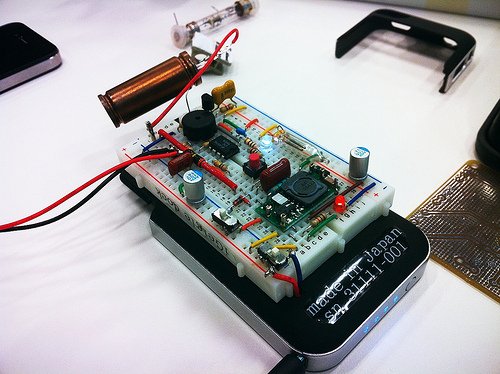
Crowdsourcing in a crisis: mapping radiation levels in Japan
Above: iGeigie from Joi on Flickr
Yesterday, we looked at crowdsourcing in crisis, taking the Middle East as an example. The thoughts came from Al Jazeera’s head of New Media Mohamed Nanabhay, who spoke on a panel at the MIT-Knight Civic Media Conference.
Today, we turn to the experiences of Joi Ito, new director of the MIT Media Lab, who has been crowdsourcing radiation levels in post-quake Japan:
On the panel, Ito said he was frustrated with the lack of useful information from Japan’s news organizations in the first few hours after the earthquake. As he monitored events from the U.S, he was glad for the rapid Twitter updates.
“People sitting in pitch dark rooms, phones aren’t working and they’re on the net or watching TV. They don’t know what to do. They don’t know if they should be running away. Twitter was offering instruction long before news organizations offered any information. In that way, they were more effective in the early hours of the crisis.”
After the nuclear plant meltdown at Fukushima, Ito’s frustration was compounded by the ongoing misinformation from the government on safe levels of radiation. Rather than relying on inaccurate reports from government agencies, Ito began working right away with a team to crowdsource Geiger counter readings and map the hot zones.
“Now we’re designing Geiger counters and deploying them to villages. These government guys would come, measure the radiation, and leave without telling anyone the results,“ Ito said.
The website Safecast.jp was up one week after the disaster, now has 50 volunteers and has raised $57,000, much of it through Kickstarter donors.
This kind of crowdsourcing project draws experts from around the world. Hackers in Tokyo and academics in Portland, OR now work on measuring and mapping radiation, and on redesigns to upgrade measuring devices. One volunteer even designed the iGeigie, a device that will work with an iPhone.
Safecast volunteers drive specially-outfitted vehicles around Japan and gather data on a granular level. They also educate people on how to manage hot spots, which can be as simple as removing top soil or as difficult as sanding concrete. (They are careful not to tell people what level of radiation is safe, as those figures are in dispute.)
All of this happened quickly because social media helped those with a common cause and common interest find each other and work together. As a unified force, they are making serious progress on providing Japan’s residents with the information they need to make safe decisions.
“We have evidence that our site has forced the government to release data,” Ito said. “They acknowledged they had been hiding the data. Social media and foreign experts have been a huge driver in forcing the evidence.”
Previous conference coverage:
Annie Shreffler is a freelance journalist writing about the MIT-Knight Civic Media Conference for Knight Foundation
Recent Content
-
Journalismarticle ·
-
Journalismarticle ·
-
Journalismarticle ·


